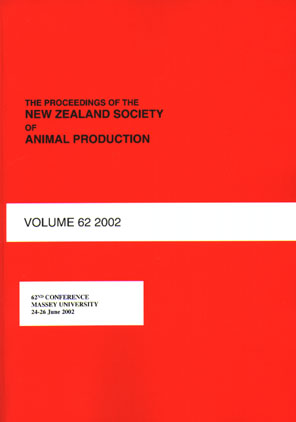Abstract
An experiment compared the grazing of deer and sheep on pasture with or without contamination by cattle dung pats. Sheep (35 ewes) and deer (24 hinds) separately grazed 0.4 ha plots of a ryegrass/white clover pasture. Half of the area (4 subplots) was contaminated with artificially applied cattle dung pats (DP), 30 cm in diameter, using fresh cattle dung at an application rate of 1 dung pat per 4 m2. The remaining four subplots were left uncontaminated (NDP). Mean pasture mass was estimated daily (rising plate meter) on DP and NDP plots. In addition, pasture height (sward stick) was recorded daily at 10 cm intervals from 0 to 100 cm from pre-marked dung pats and from pegged point sources in NDP plots. The experiment lasted 10-11 days and mean pasture mass declined from 2850 to 1500 kg DM/ha. Grazing pressure was controlled by altering numbers of livestock to maintain < 250 kg DM/ha difference between each species plot. There was no difference in the mean pasture mass of the sheep or deer grazed plots at any stage of the experiment. However both species grazed pasture near pegs (NDP plots) to a lower mean height (P<0.001) than near dung pats although the difference was greater for deer (7.4 and 9.0 cm near pegs and near dung pats respectively) than sheep (8.0 and 8.3 cm near pegs and dung pats respectively). Sward height of pasture at 10-20 cm from dung pats grazed by deer was higher than sheep grazed pasture for days 1, and 3-7 of the trial (P<0.001). The results from this experiment indicate that although deer graze pasture around cattle dung pats, they show more of a preference for grazing further away from dung pats than do sheep. This finding should help to establish the potential for deer to substitute for sheep under mixed grazing situations involving cattle.
Proceedings of the New Zealand Society of Animal Production, Volume 66, Napier, 59-63, 2006
| Download Full PDF | BibTEX Citation | Endnote Citation | Search the Proceedings |

This work is licensed under a Creative Commons Attribution-NonCommercial-NoDerivatives 4.0 International License.

